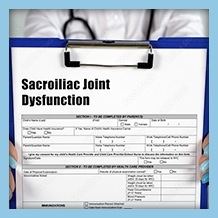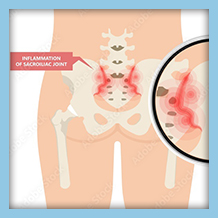

Sacroiliac joint dysfunction and impairment can contribute to lower back pain and/or pain in the legs. The pain can be particularly difficult, and may feel like sciatica or pain due to a lumbar disc problem. The sacroiliac joint lies next to the base of the spine, below and behind the lumbar spine, and above the coccyx. It connects the sacrum with the ilium (hip bone). It is often associated with low back and leg pain. This type of pain is usually experienced at night or during periods of rest.
In addition, patients who suffer from sacroiliac joint pain tend to experience other symptoms such as numbness in their legs, tingling sensations, weakness, and swelling. These symptoms can severely impact your ability to complete daily activities and tasks, and they can also result in great frustration or confusion about the circumstances. If you want to prioritize your health, well-being, and long-term independence, we encourage you to work with a surgeon from Orthopedic & Laser Spine Surgery. We can help lead you in the right direction by finding great treatment options for your circumstances.
Symptoms of Sacroiliac Joint Dysfunction
The most common symptoms of patients are lower back pain, and the following sensations in their lower extremities: pain, numbness and tingling, weakness in their legs, pelvic/buttock pain, feeling of leg instability (giving way), disturbed sleep patterns and disturbed sitting patterns (unstable when sitting for long periods, unstable when sitting).
If you experience symptoms associated with sacroiliac joint dysfunction, we encourage you to speak with a doctor for further evaluation. Your doctor can help you discern whether there are other potential causes for your experiencing pain, and your medical practitioner can also provide referrals to specialists who can give you specialized care. A spine and laser surgeon may be a helpful and reasonable option for your treatment, depending on your circumstances.
Causes and Risk Factors of Sacroiliac Joint Dysfunction
Sacroiliac pain is often caused by abnormal movement of the sacrum and pelvis. This can occur when there is a problem with the sacroiliac joints themselves or if there is a problem with muscles around the hips and legs. Sacroiliac pain can also take place when there is a problem in the spine or if there is something wrong with the nerves that run through the area.
Hypomobility
Hypomobility is a condition where there is not enough movement in the spine. It is often associated with low back pain. It is also called “fixation” because the patient cannot move their body. Hypomobility is different from immobility, which means that the patient cannot move his or her limbs.
Accidents and Sudden Impact
A car accident or another form of sudden impact can also increase your risk for sacroiliac joint dysfunction. If you have been in a crash or another incident that might have had a similar bodily impact, we recommend you seek medical assistance from a doctor.
Infections
Infection may also result in sacroiliac joint dysfunction, specifically if there is an infection in the sacroiliac joint. Infections rarely result in sacroiliac joint dysfunction, but this is a possible way to arrive at the condition. Determining whether an infection is present will generally require assistance from a medical practitioner.
Pressure or Wear and Tear on Joints
Increased pressure or wear and tear on your joints may also result in sacroiliac joint dysfunction. Two of the most common ways this happens include pregnancy and arthritis. In particular, osteoarthritis can develop in your joints and affect your ability to function normally. Ankylosing spondylitis can also lead to this condition.
Pregnancy can cause the sacroiliac joints to loosen or stretch, and the added weight of carrying a child can put excess stress and pressure on this area. If you experience a great deal of pain during pregnancy, we encourage you to speak with your doctor instead of ignoring the issue. Excess pain can point to an underlying condition that requires treatment and attention to prevent unnecessary damage.
Diagnosis of Sacroiliac Joint Dysfunction
Sacroiliac joint dysfunction is often misdiagnosed because the symptoms mimic other conditions, including other mechanical conditions like facet syndrome and low back pain. Diagnosis is usually made after eliminating other causes. Physical exams and imaging studies may be utilized to confirm the diagnosis. Sacroiliac joint injections are commonly used to treat the condition.
You can receive a diagnosis with help from a doctor, but visiting a spine specialist may also be helpful. If your issues are not obvious, a non-specialized practitioner may have difficulty discerning your condition and providing adequate care and suggestions. This may also save you time, as a general practitioner may tell you to see a specialist if they are unsure. A spine specialist will likely have more experience with your condition and be better able to provide you with an accurate diagnosis.
Treatment of Sacroiliac Joint Dysfunction
Sacroiliac joint dysfunction treatments are usually conservative (nonsurgical), and they focus on restoring normal motion in the joint. Some common treatment options include the following:
- Ice, heat, and rest.
- Acetaminophen, as well anti-inflammatory medications (like ibuprofen or Naproxen) to reduce swelling that is usually contributing pain.
- Manipulation is an important treatment method for many conditions. Manual manipulation is often done by a chiropractor, an osteopath, or another qualified health practitioner. Manipulation can be performed using various techniques, including side posture manipulation, drop technique, and blocking techniques.
- Supports or braces for hypermobile joints.
- Controlled physical therapy may be helpful in strengthening the muscles around the sacrum and increasing range of motion.
- Gentle, low impact aerobic exercises will also help increase blood flow to the area, stimulating a healing response.
- Severe pain may require water therapy, as the water provides a buoyant effect for the body and reduces the stress on the painful joint, while also providing a soothing environment.
- Sacroiliac joint injections.
- Surgery is an option to treat sacroiliac joint dysfunction when other treatments fail. Sacroiliac joint fusion is a surgical procedure that involves fusing together the two bones of the sacroiliacs. This stops the pain caused by abnormal movement of the sacroiliac joints.
There are several treatment options for sacroiliac joint dysfunction, ranging from conservative treatments to surgical procedures. If you suspect you might have sacroiliac joint problems, there are many ways to treat the condition. Your spine surgeon can walk you through your treatment options to find relief quickly.
More Information About Surgical Procedures for Sacroiliac Joint Dysfunction
Depending on the severity of your condition, more conservative measures may be less invasive and just as effective at addressing the pain and other issues. Most doctors will recommend that you try some less invasive treatments before utilizing a surgical procedure. One such surgical procedure to help with this condition is sacroiliac joint fusion, where a surgeon will attempt to stabilize the joint and reduce pain. While this can reduce abnormal movement and the pain you experience, other options are also available.
A few other minimally-invasive surgical treatments can include nerve ablations or joint injections. Before making a final decision about your treatment options, we suggest you speak with a specialist. A spine and laser surgeon from OLSS can help you determine whether a surgical procedure is appropriate for your circumstances.
Prevention of Sacroiliac Joint Dysfunction
If you have sacroiliac joint dysfunction, you may experience pain or discomfort in the lower back area. This can be caused by many different factors, including poor posture, lack of exercise, stress, and even pregnancy. However, if you are experiencing this type of pain, there are some things you can do to help prevent it.
Here are some tips to keep in mind:
- Avoid sitting in one position for long periods of time: When seated, make sure your feet are flat on the floor, and your knees are slightly bent. Avoid slouching, especially when reading or watching television.
- Exercise regularly: Exercise helps strengthen the muscles surrounding the sacroiliac joint, reducing the risk of injury. You should perform gentle stretching exercises at least three times per week.
- Maintain good postur: Poor posture can lead to muscle strain and tension in the back and neck areas. To maintain proper posture, sit up straight with your shoulders pulled back and down. Keep your head upright and avoid looking forward.
Preventing sacroiliac joint dysfunction can help you avoid a great deal of pain, but participating in these activities can also help you during and following any treatments or procedures you undergo. If you want further information on what your lifestyle should look like following treatment, we encourage you to work with a spine specialist like a surgeon from OLSS. We can give you detailed information and tailor recommendations to your needs.
Schedule a Consultation With a Trustworthy Spine Surgeon at Orthopedic & Laser Spine Surgery
If you are suffering from back pain or have been diagnosed with sacroiliac joint dysfunction, schedule a consultation with a trustworthy spine surgeon who can help you get rid of this problem once and for all. A good spine surgeon should be able to diagnose the condition correctly and offer the best treatment options available.
Contact Orthopedic & Laser Spine Surgery to learn more about available treatment options. You can schedule an appointment through our contact form or call our office at (855) 853-6542. If you want assistance finding the best treatment option for your condition and lifestyle, we are happy to discuss more details about your circumstances. We look forward to working with you and providing you with the outstanding patient care you need and deserve.
